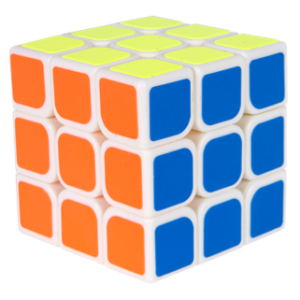By: Elle Nanstein
In 1974, Erno Rubik, a Professor of Architecture in Budapest, Hungary, created a six-sided, colorfully decorated cube puzzle in an effort to provide new and exciting ways to present information to his students. Though it took over a month for Erno to work out the solution to his puzzle, he was able to use the Cube’s first model to explain the science behind spatial relationships. As its creator, Erno envisioned the Cube as “an object of art, a mobile sculpture symbolizing stark contrasts of the human condition: bewildering problems and triumphant intelligence; simplicity and complexity; stability and dynamism; order and chaos.”
After presenting his prototype to his students and friends, Erno began to realize the potential of his Cube and sought to begin the manufacturing and distribution process under the name “Magic Cube.” Due to Hungary’s involvement in the Communist regime, Erno knew that the only way for the Cube to obtain worldwide recognition was to get his invention out of the country. This was accomplished partly by a Hungarian entrepreneur who took the cube to the Nuremberg Toy Fair in 1979, where Tom Kremer, a toy specialist for Ideal Toy Company, agreed to sell it to the rest of the world. However, Ideal Toy’s executives thought that the designation “Magic Cube” had overtones of witchcraft and decided to rebrand the product, eventually settling on the iconic name, “Rubik’s Cube.”
Since its launch in 1980, an estimated 350 million Rubik’s Cubes have been sold and it is approximated that one in seven people alive have played with a Rubik’s Cube. According to its official website, “the beauty of the Rubik’s Cube is that when you look at a scrambled one, you know exactly what you need to do without instruction. Yet without instruction it is almost impossible to solve, making it one of the most infuriating and engaging inventions ever conceived.”
Unfortunately, the international success of the Rubik’s Cube has put the product at risk for trademark infringement. On August 28, 2017, Rubik’s Brand Limited filed a complaint in the U.S. District Court in Manhattan against Duncan Toys Co., its pa rent company Flaumbeau, Inc., and the retailer Toys “R” Us in an effort to halt sales of Duncan’s “Quick Cube,” an alleged knockoff (pictured left). According to the complaint, Duncan’s cube “mimics the features and overall appearance” of the Rubik’s Cube, mainly differing in its colors and “slight rounding” of the corners. The company is also seeking to hold Toys “R” Us liable for selling Duncan’s cubes.
rent company Flaumbeau, Inc., and the retailer Toys “R” Us in an effort to halt sales of Duncan’s “Quick Cube,” an alleged knockoff (pictured left). According to the complaint, Duncan’s cube “mimics the features and overall appearance” of the Rubik’s Cube, mainly differing in its colors and “slight rounding” of the corners. The company is also seeking to hold Toys “R” Us liable for selling Duncan’s cubes.
Rubik’s Brand Limited asserts that “as a result of Defendants’ use of a spurious version of Plaintiff’s federally registered Rubik’s Design Mark, consumers who expect to receive Plaintiff’s Rubik’s Cube puzzle, for which Plaintiff has developed a national and international reputation, will be disappointed when using Defendants’ imitation twist puzzle cube. This will cause irreparable harm to Plaintiff’s reputation and the goodwill which is symbolized by the Rubik’s Design Mark.” Rubik’s Brand Limited hopes to recover alleged illegal profits and triple damages, and seeks an order permitting the destruction of the unauthorized cubes. Whether the company will be able to maintain exclusive rights to the cubed puzzle remains uncertain at this time.
Cites:
The History of the Rubik’s Cube, Rubiks.com, https://www.rubiks.com/about/the-history-of-the-rubiks-cube (last visited Sept. 4, 2017).
Complaint, Rubik’s Brand Ltd. v. Flambeau, Inc., Duncan Toys Co., Toys “R” Us, Inc., WL 3724670 (S.D.N.Y. 2017) (No. 1:17-cv-06559).
New Rubik’s 3×3 Cube, Rubiks.com, https://www.rubiks.com/store/cubes/new-rubiks-3×3-cube (last visited Sept. 4, 2017).
Quick Cube 3×3, Yo-Yo.com, https://www.yo-yo.com/Quick-Cubes/Quick-Cube-3-x-3-3901QC (last visited Sept. 4, 2017).
